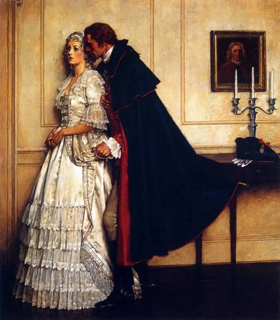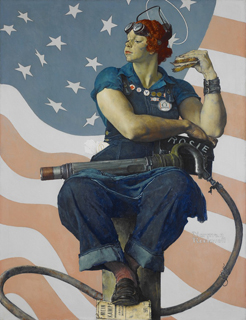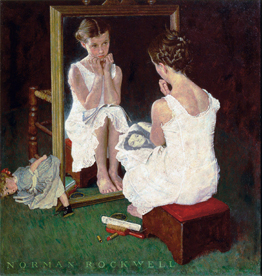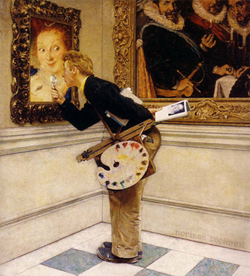Norman Rockwell and voyeurism
Norman Rockwell was America's greatest painter. Below are four of his iconic images, which I chose because they appear to spy on private moments. They are Rorschach tests that invite different interpretations - optimistic, pessimistic, cynical and agnostic.
Under Fair Use I have included thumbnails but to really study these paintings in the large you would need to find them online. One thing to notice: all four paintings tell stories, driving our eyeline to the top left corners...

Above is Forgotten Facts about Washington, which appeared in Ladies' Home Journal in February of 1932. The illustration was accompanied by this line: "When Washington failed - Because I did not wait until ye ladye was in ye proper mood."
So, which "forgotten fact" is referred to? Is this George and Martha Washington and is it saying that even heroic national leaders indulged in sex - or tried to and got turned down - just like the rest of us?
No, that would be a modern thing to say. This illustration actually accompanied an article about Washington's love for Sally Fairfax in the year before he married Martha. Fairfax was married at the time and a sexual relationship is unlikely, so this cover - and the byline especially - are as risqué and as misleading as you could get in 1932. (Rockwell would have had nothing to do with the byline.)
This magazine story ran in the year of the Bicentennial of Washington's birth so it joined a flood of optimistic books and articles, highbrow and lowbrow, that continued all year. It would include a popular historical novel called The Heart of George Washington: A Simple Story of Great Love, by Bernie Babcock. You might say, then, that the final gaze takes us to Sally Fairfax, who was the "forgotten fact"...
The three next paintings, however, bring out the worst in art and literary critics, Rockwell biographers, journalists and other commentators, especially those predisposed to Abstract Expressionism and Freudian psychoanalysis. If they aren't throwing the word kitsch around they are mocking Rockwell for his cheerfulness, his "disavowal" of sexuality, his "lack" of manliness and his "peeping." This is the prevailing cynical option.

Rockwell himself used the jargon of psychoanalysis - in some of his painting titles and in his 1960 autobiography, My Adventures as An Illustrator, and it's true he underwent therapy with Erik Erikson. Perhaps he was looking for a solution to his first two wives' (and thus his own) depression and perhaps he found it in his painting. But his biographers and even his own family have considered him a bit immature and a "naif," while they also have acknowledged that perhaps it was because he was "impulsive" and that, after all, he succeeded with his third marriage. But this is damning with faint praise.
Rockwell's "rehabilitation" really began in the mid-1990's. On the one hand this was because it became apparent that his personal life was nothing like his idyllic paintings. But the more telling discovery was that he had a sophisticated sense of irony and it's right there in the paintings. Not just in his clever homages to Michelangelo, Hals, Velásquez and the like, but in his ability to tell a story that permits disparate interpretations. It is Rockwell's intellectual agnosticism and self-deprecating sense of humor that has been the least appreciated till now, because if you only go looking for one meaning in a painting, that is all you ever will find.
Up above is Rosie the Riveter, a famous image that was used on a Saturday Evening Post cover in 1943 to support the war effort - the final gaze to the top left takes us to the flag. But, Rockwell's critics focus on the riveting gun she holds, inspiring them to describe it as a massive phallic symbol - a "strap-on" - and her physicality is said to be "masculine." One biographer claimed in the Wall Street Journal no less, that Rosie is masturbating. There is also no effort made to redefine "femininity" so as to incorporate Rosie's hefty build. These critics seem willing to diminish big and chunky women as unsexy. They ought to get out more often - and focus less on looking for Lacanian phalluses.

Above is the endearing Girl at Mirror, a Saturday Evening Post cover from 1954. Another biographer, Richard Halpern, claims that innocence is "manufactured" and "a pretense." The biographer I mentioned says the doll in the painting is masturbating. Well then... But, whatever else it is, innocence exists just as much as a subjective experience; it is not solely a projection by others. Furthermore, innocence does not cease at puberty; it can remain throughout adult life and it may have been what kept Rockwell going. The final gaze toward the painting rests on that thoughtful face in the mirror, inviting the viewer to identify with her - if they can get past their pessimism...

Above is The Art Critic, a Saturday Evening Post cover from 1955. Is the boy peering at her cleavage or the brooch around her neck. We don't know of course, although the portraits on the wall appear to think it's the cleavage. But what should be viewed as a witty and humorous image has inspired critical rants about perversity once it became known that the boy in the picture is Rockwell’s son, and the woman is Rockwell’s wife Mary. The entire painting is - the horror - an Oedipal joke - one that his family found embarrassing. I don't find their reactions particularly believable myself but, even if they were offended, so what? This painting strikes me as agnostic - believe what you want to believe...
Photos: © The Norman Rockwell Estate /Licensed by Curtis Publishing.
